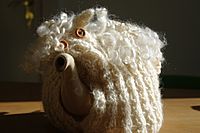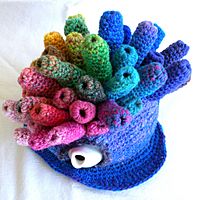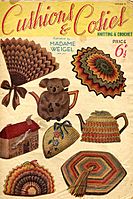Tea cosy facts for kids
A tea cosy is a special cover for a teapot. It's usually made of cloth. Its main job is to keep the tea inside the pot warm. Think of it like a warm hat for your teapot! People used tea cosies long before vacuum flasks were invented. Some tea cosies even have soft padding inside that you can take out and wash.
Some tea cosies look like woolly hats. They are hand-knitted and might even have a fluffy ball (called a pom-pom) on top. This pom-pom can also help you lift the cosy off the teapot. Sometimes, in restaurants or hotels, teapots have a tea cosy with a metal outside. This metal layer helps protect the fabric inside and keeps the tea even warmer. A special type is the tea lugger. It helps you carry a hot teapot around easily.
Tea cosies can be part of a matching set. These sets might include tablecloths, place mats, egg cosies, oven gloves, or aprons. Cloth tea cosies can be embroidered with beautiful designs. This can make them match a fancy set of china cups and plates. Some tea cosies even have secret pockets. These pockets can be filled with sweet-smelling herbs or flowers, like a potpourri.
History of Tea Cosies
The idea of covering a teapot might have started when tea first came to Britain from China in the 1660s. However, the first time a tea cosy was officially mentioned in Britain was in 1867.
Many people believe the Duchess of Bedford helped make tea cosies popular. In 1840, she started the tradition of afternoon tea. This was a time for people to meet, chat, and catch up on news. With all the talking, the teapot would often get cold. This sometimes made tea parties end sooner than people wanted. So, the tea cosy became a helpful invention!
Tea cosies became very popular in the late 1800s. They were found in many homes across Britain. This was part of a trend during the Victorian era where people loved to decorate and cover many objects in their homes.
Tea cosies also started being used in North America around the same time. Old newspapers show that tea cosies suddenly became very popular with women who hosted tea parties. These newspapers even gave advice on how to make one. They suggested using strong fabric like brocade or linen. They also said to make it big enough for your teapot and add a ring on top to lift it off.
Tea Cosies in Art and Books
Tea cosy needlework (sewing and decorating with needles) is seen as an art form. The Norfolk Museums and Archeology Service has a collection of this art by modern British artists.
Tea cosies have even appeared in books! For example, there's a book by Edward Gorey called The Haunted Tea-Cosy.
A famous quote from Scottish comedian Billy Connolly is: "Never trust a man who, when left alone in a room with a tea cosy, does not try it on." This shows how funny and unique tea cosies can seem.
Australian author Loani Prior wrote books called Wild Tea Cosies and Really Wild Tea Cosies. These books were so popular that they made the Top Ten bestseller list in Australia in 2008 and 2010. Loani's creative tea cosies have also been shown in the Powerhouse Museum.
-
An elaborate Coral Tea Cosy, crocheted to suggest the appearance of a Coral reef
See also
 In Spanish: Cubretetera para niños
In Spanish: Cubretetera para niños







